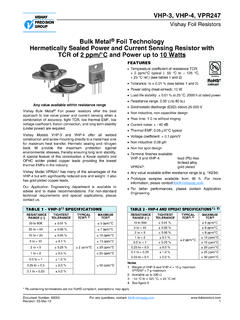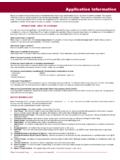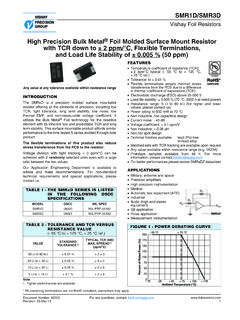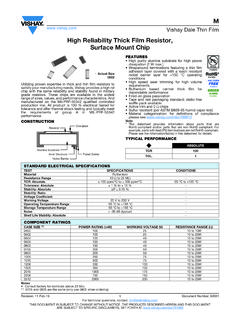Transcription of AN4506 Calculation of Junction Temperature
1 AN4506 Application Note TGD-1X. AN4506 . Calculation Of Junction Temperature Application Note Replaces September 2000 version, July 2002. There are a number of ways of calculating the Junction rating a device for a given application maximum toler- Temperature of a device. These involve various levels of ances should be taken into account. The only way of complexity from a quick hand Calculation to a full three evaluating a system fully , is to build it using an approxi- dimensional finite element analysis, with various shades mately rated device, and test the thermal circuit. of complexity between these two extremes. Examples of these various methods are spread sheets and simulation 1. power LOSSES: programs which use some form of mathematical model. When rating a device for a given application the designer The total power dissipation in a device is the sum of the must select an appropriate type and ensure that absolute switching losses(turn on and turn off), conduction losses, maximum ratings are not exceeded.
2 The device selected off state losses and the drive input losses. Only the first 2. must be rated for the worst case conditions it is likely to of these quantities are generally significant, and at lower see. If the device rating does not match the circuit require- frequencies only the conduction losses are significant. ments either a new type must be selected or the circuit design changed. Alternatively if the device is expected to 2. Calculation METHODS: fail the circuit must be designed to allow safe failure. Almost all power semiconductor ratings and characteris- The superposition theorem is based upon rectangular tics are related to the Junction Temperature . Consequently pulses of power , non rectangular pulses are converted in reliable Calculation of Junction Temperature , both transient rectangular pulses with the same peak power levels, but and steady state is very important.
3 For simple continuous with reduced on periods fig 1. The transient thermal current waveforms eg dc, 1/2 sinewave, rectangular waves impedance for a given duty cycle can be derived from the etc, used with thyristors rectifiers and GTOs, standard transient thermal impedance single pulse curve fig 2. equations given in textbooks can be used to determine the Junction Temperature for a given power loss and thermal P (W). impedance. These are easy to use to calculate Tj. For P1. irregular shaped current waveforms the pulses can often be approximated to a series of equivalent energy rectan- P2. gular pulses. The superposition theorem can then be used for calculating the Junction Temperature of a device. This theorem uses the power losses of a circuit in conjunction with the transient thermal impedance curve to calculate the Junction Temperature of a device.
4 T Complex power waveform Junction Temperature calculations are extremely depend- P (W). ant on good thermal contacts from chip to heatsink. The chip to case characteristics are guaranteed by the manu- P1. facturer, but the case to heatsink characteristics are P2. dependent upon the way in which the user mounts the device to the heatsink, surface flatness etc. The final operating conditions with in a given application, ambient Temperature , heatsink thermal resistance etc all affect the final Tj of the device. In any mathematical model used for the Calculation of Junction Temperature , variables such as t these can only be guesstimated from worst case condi- Modified power pulse waveform tions, taking into account reasonable engineering com- promises regarding heatsink flatness etc.
5 In real life these values can never be known with 100% accuracy and when 1/5. AN4506 Application Note K. d c b d = tp a a: = single pulse b: = tp T. c: = T Zth = K. Rth d: = 0. Typical transient thermal impedance From the superposition theorem assuming that Tj is responding to the average power over a long pulse train the maximum Junction Temperature can be quickly derived as follows. Tj-Tc = . Pmax. Rth - . Pmax. rth(tp+T) + Pmax. rth(tp+T) - Pmax. rth(T) + Pmax. rth(tp) [1]. The above is often simplified as follows Tj-Tc = . Pmax. Rth - Pmax. rth(tp) + Pmax. rth(tp) [2]. Rewriting the above Tj-Tc = Pmax. ( + (1 - ) rth(tp)/Rth) Rth [3]. Transient thermal impedance for different duty cycles is generally defined as shown below. Z(tp, ) = ( + (1 - ) rth(tp)/Rth) Rth [4]. Peak power = (Tj-Tc) / Z(tp, ) [5].
6 The above equations are suitable for continuous power pulses but can be adapted for other wave forms. The power pulse train may include turn on losses, conduction losses and turn off losses. These can be added together to give the average power for the pulse and then the superposition theorem can be used for the pulses immediately following this period to determine the Junction Temperature at the end of each period. Pav = F (Eon + Econd + Eoff) [6]. this equation takes a complex wave shape and approximates it to a single power pulse. Econd = V x I x ton = V x I x x T = Ppeak x x T [7]. Pav = F (Eon + Ppeak x x T + Eoff) [8]. T = 1/F [9]. Pav = F ( Eon + Eoff) + Ppeak x [10]. Using the same reasoning as above For turn on Tjmax 2/5. AN4506 Application Note TGD-1X. Tj-Tc = Pav.
7 Rth - Pav. rth(ton) + rth(ton) x Eon/ton [11]. For Tj at end of conduction period Tj-Tc = Pav. Rth - Pav. rth(tcond) + Pcond x rth(tcond) + rth(tcond + ton) x Eon/ton - rth(tcond) x Eon/ton [12]. For Tj at end of turn off period Tj-Tc = Pav. Rth - Pav. rth(toff) + rth(toff) x Eoff/toff + Pcond x rth(tcond + toff) + rth(tcond + ton + toff) x Eon/ton - rth(tcond + toff) x Eon/ton - Pcond. rth(toff). [13]. A further approximation often made to the above equations is of the following form whereby;. Pmax = F (Eon + Eoff) + Ppeak [14]. Tj - Tc = Pav. Rth - Pav. rth(tp) + Pmax. rth(tp) [15]. this is then rearranged to give Tjmax = Pmax ( D. Rth - D. rth(tp) + rth(tp)) + Tc [16]. or Tjmax = Pmax. Z(tp,D) + Tc [17]. 3. HEATSINKS: Because of thermal capacitance, heat sinks generally only respond to average power except at low frequency.
8 At low frequencies the delta Tj within a given device may be appreciable. This situation occurs in rail traction applications. The thermal impedance of a heatsink is governed primarily by its mass, surface area, coolant flow-rate, and the material from which it is made (ie specific heat capacity, thermal capacitance and thermal resistivity. Some typical values are included in figure 3). Many other factors can affect a heatsinks performance such as the size of the heat source placed on the heatsink, the orientation of the heatsink etc. Tc - Ta = Pav. (Rth(c-h) + Rth(h-a)) [18]. Combining the equations for heatsink and device the Tjmax can be approximated to Tjmax = Pmax. Z(tp,D) + Pav. (Rth(c-h) + Rth(h-a)) + Ta [19]. 3/5. AN4506 Application Note The above method of calculating Junction Temperature is Material Density Specific Heat Thermal Conductivity (kg/m3) (kg/m3) (W/m C) relatively accurate to within a few degrees and works well.
9 It can be seen from typical transient thermal impedance Alumina 800 3900 25. curves that as ton increases to periods of >1 second Tjmax Aluminium 710 201 can be calculated directly from the steady state thermal Copper 385 8930 394 impedance as Z(tp, ) a Rth. as frequency increases Tj responds more to the average power than the peak power Solder 175 9724 35. and peak Junction Temperature rise Junction Temperature Silicon 750 2400 100 rise, in many applications Calculation of the average Water 998 Junction Temperature is all that is necessary. Air The methods described above are suitable for all different Oil 800 types of semiconductors Diodes, Thyristors GTOs , Fig. 3 IGBTs, Bipolars, FETs etc. Specific Heat Capacity 6. NOMENCLATURE: = Specific Heat x Density x Volume c-h Case to heatsink Thermal Resistance = Duty Cycle = tcond/Period 1/Thermal Conductivity x thickness/area D Normalized Duty Cycle = Pav / Pmax Eon Turn On Energy 4.
10 COMPUTER SIMULATION: Econd Conduction Energy Eoff Turn Off Energy A more complete solution via a hand Calculation method F Frequency starts to become prohibitive at this level, and the use of h-a Heatsink to ambient simulation programs or spread sheets to calculate junc- j-c Junction to case tion temperatures become useful. Pav Average power Pmax Maximum power 5. ACCURACY OF CALCULATIONS- Ppeak Peak power LIMITATIONS: Rth Steady State Thermal Resistance rth(tp) Single Pulse Thermal Impedance It should be noted at this stage that the actual Junction T Period = 1/F. Temperature cannot be calculated accurately to within a Ta Ambient Temperature couple of degrees under switching operations, due to it Tc Case Temperature being extremely difficult to work out exactly how the tcond Conduction Period current is distributed over the surface of the chip.






